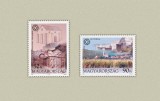
1. MAGYAR - VILÁGÖRÖKSÉG MAGYARORSZÁGON III. - Bélyeg rendelési kód: 2006 év bélyegei kompletten
2. ENGLISH - WORLD HERITAGE SITES IN HUNGARY III. - Order code of the stamp: 2006 Year stamps complete
3. GERMAN - Welterbe in Ungarn III. - Marke die sprechstunde kode: 2006 Jahr Briefmarken komplett
1. MAGYAR - VILÁGÖRÖKSÉG MAGYARORSZÁGON III.
A Magyar Posta Zrt. a Pécsi ókeresztény sírkamrák és a Fertő/Neusiedlersee kultúrtáj bemutatásával folytatja a magyarországi világörökségek bélyegképen történő megörökítését.
Minden nemzet fontos feladata saját kultúrájának, történelmének, hagyományainak gondozása. A helyi jelentőségű értékek mellett vannak olyanok, amelyek az egész emberiség számára fontosak. Ezek védelméről határozott az UNESCO 1972-ben, amikor létrehozták a Világ-örökség Bizottságot és elfogadták az „Egyezményt a világ kulturális és természeti örökségének védelméről.”
Fertő/Neusiedlersee kultúrtáj (2001) A Fertő-tavat az UNESCO 1979-ben egyedi természeti értékei miatt bioszféra rezervátummá nyilvánította. A Világörökség Bizottság mindazonáltal - Magyarország és Ausztria példamutató együttműködésben és közös irányelvek szerinti előterjesztése alapján - a Fertő-tavat / Neusiedlerseet az azt övező településekkel együtt 2001-ben mint kultúrtájat vette fel a
Világörökségi Listára. A tó és környéke 8000 év óta különböző kultúrák találkozópontja, melyen az emberi tevékenység és a földrajzi környezet evolúciós szimbiózisának eredményeként egy egyedi kulturális tájegység alakult ki. A vidéknek a természeti értékek mellett figyelemre méltó a népi építészete, több jelentős 18-19. századi kastélya pedig jelentős kulturális látnivalót jelent. A tó háromnegyede Ausztriában fekszik, a régiót azonban mégis olyan természeti egységnek tekinthetjük, amelyre nincs nagy hatással a földrajzi megosztottság.
A bélyegeken megtalálható a világörökség embléma, amely a kulturális és természeti javak között fennálló szoros kapcsolatot, kölcsönhatást szimbolizálja. A központi négyzet egy emberi kéz által alkotott formát jelképez, miközben a kör a természetet, természetességet jeleníti meg. Mindkét forma szorosan egymásba fonódik, egyik a másikból indul ki és tér vissza. Az embléma kerek mint földünk, és a kör egyben a mindent körülölelő védelem egyik szimbóluma is.
A bélyegsorozat egyes címleteihez – az adott területhez kapcsolódó látképét bemutató – alkalmi boríték készült. Az alkalmi bélyegző grafikáján mindkét tájegység hangulatát idéző grafikai kompozíció látható.
Megjelenési időpont: 2006. március 16.
Forrás: Philatelia Hungarica Kft., Magyar Posta
2. ENGLISH - WORLD HERITAGE SITES IN HUNGARY III.
Magyar Posta is continuing its presentation of stamps showing World Heritage sites in Hungary with the early Christian necropolis in Pécs and the Fertő-Neusiedler Lake cultural landscape.
It is important for every nation to nurture its own culture, history and traditions. Besides assets of local value, there are some of import for the whole of mankind. To protect these, UNESCO created the World Heritage Commission and adopted the “Convention concerning the Protection of World Cultural and Natural Heritage” in 1972.
Early Christian necropolis in Pécs (2000)
The 4th-century early Christian cemetery of the Roman town of Sopiane (modern day Pécs) was placed on the list of cultural treasures by the World Heritage Commission in 2000 with the justification that the early Christian sepulchral art and architecture of the northern and western Roman provinces is fully and excep-tionally well illustrated by the cemetery’s structures and frescoes. The underground burial chambers and memorial chapels bear witness to the strength and faith of the Christian communities of Late Roman Europe, and also show the roots of a culture and civilisation that has survived up to the present day and continues to influence it.
Lake Fertő was declared a biosphere reserve by UNESCO in 1979 due to its unique natural values. The World Heritage Commission placed Fertő-Neusiedler Lake and its surrounding area on the list of World Heri-tage as a cultural landscape in 2001 based on a Hungarian-Austrian proposal drawn up with exemplary co-operation on joint guidelines. The lake area has been a meeting place for different cultures for eight millen-nia. This unique cultural landscape is the result of an evolutionary symbiosis between human activity and the physical environment. Besides its natural values, the remarkable rural architecture of the villages and several 18th- and 19th-century palaces add considerable cultural interest to the area. Three quarters of the lake is in Austria, yet the region has a physical unity little affected by geographical division.
The World Heritage emblem, symbolising the close connection between and mutual impact of cultural and natural assets, features on the stamps. The central square represents a form created by human hand, while the circle stands for nature and naturalness. Both forms are integrally linked, starting from and returning to each other. The emblem is round like the earth and the circle is a symbol of embracing protection.
There is a first day cover for each denomination of the set of stamps, showing a view of the respective areas. The design of the special postmark shows a graphic composition evoking the ambience of both sites.
Source: www.unesco.hu www.vilagorokseg.hu
Date of issue: 16 March 2006
3. GERMAN - Welterbe in Ungarn III.
Die Ungarische Post Co. in den frühen christlichen Gräbern und der Universität Pécs Neusiedl / Neusiedlersee Cultural Heritage in Ungarn wird auch weiterhin präsentieren den Stempel der Verewigung.
Wichtige Aufgabe der eigenen Kultur jeder Nation, Geschichte und Traditionen der Pflege. Eine lokale Werte sind diejenigen, die für die ganze Menschheit von Bedeutung sind. Dabei handelt es sich dem Schutz der UNESCO beschlossen, im Jahr 1972, die das Welterbe Komitee gegründet, und nahm das "Übereinkommen über den Schutz des Weltkultur-und Naturerbes."
Neusiedl / Neusiedlersee Cultural Landscape (2001) Der Neusiedler See von der UNESCO im Jahr 1979 wegen seiner einzigartigen natürlichen Werte zum Biosphärenreservat erklärt. Das Welterbe-Komitee, jedoch - Ungarn und Österreich und die vorbildliche Zusammenarbeit auf der Grundlage gemeinsamer Leitlinien für die Vorlage - die Region Neusiedler See / Neusiedlersee zusammen mit den umliegenden Gemeinden im Jahr 2001, nahm die Kulturlandschaft als
World Heritage List. Der See und seine Umgebung seit dem Jahr 8000 Treffpunkt verschiedener Kulturen, in denen menschliche Aktivitäten und geografischen Umfeld des evolutionären Ergebnis einer einzigartigen kulturellen Symbiose Region zu entwickeln. Die Landschaft der natürlichen Werte bemerkenswerte Architektur des Volkes, eine erhebliche Zahl von 18-19. Jahrhundert erbaute Schloss und stellt einen wichtigen kulturellen Sehenswürdigkeiten. Der See ist drei Viertel von Österreich liegt in der Region, aber immer noch als eine natürliche Einheit, für die es einen großen Einfluss auf die geografische Kluft betrachtet.
Die Marken können auf der Welterbe-Logo, das die natürlichen und kulturellen Erbes in enger Beziehung ist, symbolischen Interaktion gefunden werden. Der zentrale Platz gebildet durch die Form einer menschlichen Hand als Symbol für den Kreis, während die Natur, angezeigt Natürlichkeit. Beide Formen sind eng ineinander greifen, das eine vom anderen auf und kehrte zurück. Logo der Erde rund und lang in einem der Rundum-Schutz Eines der Symbole.
Die Marken der jeweiligen Bezeichnung - in jedem Bereich Landschaft zugehörige Präsentation - made gelegentliche Umschlag. Region sowohl die gelegentliche Stempel Grafiken Atmosphäre Zusammensetzung wie in der Grafik.










